Baroque style arose in the 17th century. According to many researchers, he was the last style that covered all Europe, manifested in almost all forms of art. Baroque was not only a style of art, but also a way of life. This direction and furniture affected.
Modern equipment for restaurants or office furniture is by no means similar to Baroque works, although their elements can sometimes be found in the work of modern furniture designers. The origin of this name itself is quite vague. Most often you can hear that Baroque is a word that was called in southern Europe a pearl of irregular shape. Signs of this style were splendor, thoroughness, desire for decoration, which often seems unnecessary. Gilding, the use of precious wood – this is also characteristic of Baroque furniture. Baroque chairs, tables, beds, cabinets were massive, they were covered with carvings, overlays from precious metals. The legs of tables and chairs were made in the form of lion paws or even the paws of completely unprecedented monsters. The fantasy of the masters of this era was sometimes so violent that the imagination of even the most sophisticated connoisseurs of the history of furniture is still amazing.
In Russia, Baroque became especially popular in the middle of the 18th century. At this time, Baroque was combined with another, more elegant style – Rococo, characteristic of aristocratic houses. It often happened that the furniture was designed by architects who were trying to create the building in such a way that all its elements were in harmony with each other as best as possible. So, many samples of furniture for the palaces of St. Petersburg were created by the famous architect B. Rastrelli, the author of the Winter Palace and many other buildings, still considered the greatest works of art. It is curious that in the middle of the 18th century, the Russian Imperial Courtyard was not very rich in furniture. She was transported from the palace to the palace, but even what was there was not always enough.
Very popular at this time is a baroque garden furniture. Just in this era there is a considerable interest in garden arts. Any palace, any estate necessarily has a garden designed for walking and amusements. Massive benches and armchairs stood in such gardens, in which people tired of walking could relax. Furniture in the style of Russian baroque, both garden and the one that was intended for the interior, was decorated with gilding. An important element of jewelry was thread. Furniture workers cut out on their legs, backs, seats flowers, fruits, birds and other patterns that usually added volume. A chair or a wardrobe could turn into one continuous pattern or a complex of patterns.
In the XVIII century there was a fashion for upholstered furniture. Although this trend was born in the bowels of such a style as classicism, Russian Baroque also borrowed it. At the same time, wallpaper on the walls appeared, which often made not from paper, but from fabric, and the upholstery of baroque furniture tried to correlate with the tone of the walls of the room for which it was intended.
Modern furniture industry produces a huge number of furniture items – tables, chairs, cabinets, sofas, hotels, chairs for offices, etc. D. Furniture designers draw their inspiration from a variety of historical eras. It often happens that even now, in the 21st century, they turn to the creative heritage of Baroque.








